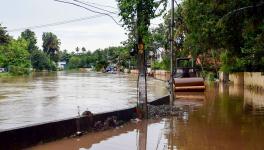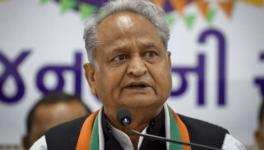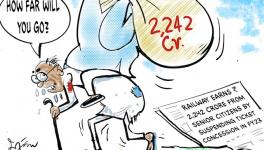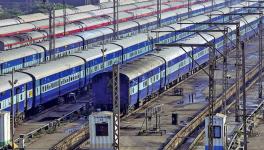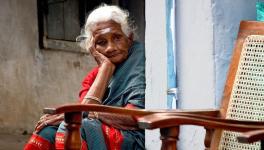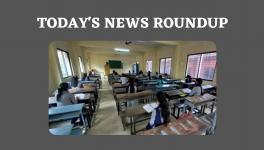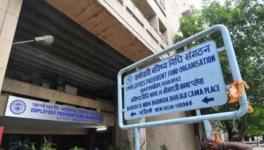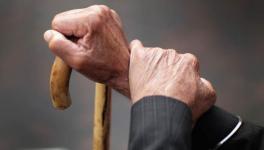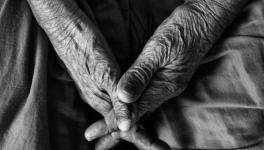Only 1 out 3 BPL Senior Citizens Receive Benefits of Pension Schemes, Says Govt Study
New Delhi: Only 30% of India’s senior citizens from below-poverty-line households received benefits from the Indira Gandhi National Old Age Pension Scheme (IGNOAPS), estimated a recent survey by the Union government on the country’s ageing population. The scheme, launched in 1995, provides Rs 600-Rs 1,000 to the elderly who live below the poverty line (BPL).
Also, only 55% of those aged 60 and above were aware of the scheme, says the Longitudinal Ageing Study in India (LASI), which was carried out by the National Programme for Health Care of Elderly (NPHCE), and International Institute for Population Sciences (IIPS) under the Ministry of Health & Family Welfare (MoHFW) in collaboration with Harvard University’s T. H. Chan School of Public Health and University of Southern California. The study, which was released earlier this week, surveyed 72,250 older adults above the age of 45, across 35 states/Union territories (UTs) from April 2017 to December 2018.
The awareness and enrolment for two other well-known social security schemes for the elderly were even lower, according to the study. A majority of the elderly population (54%) said that had not heard about the Indira Gandhi National Widow Pension Scheme (IGNWPS), which provides Rs 300 to widows above the age of 40 in the BPL category. Less than a quarter of them received the pension in the duration of the study from April 2017 to December 2018.
The Kendriya Annapurna Yojana (a scheme that distributes foodgrains to BPL citizens over the age of 65) benefits only 2.5% of the urban elderly population and 1.5% of their rural counterparts. Less than 13% of the senior citizens in the villages and cities of India are aware of the scheme.
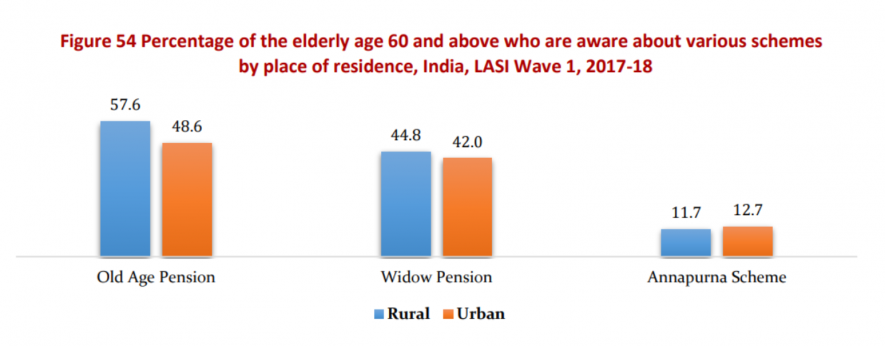
The study also found that only 6% of the officially retired elderly age 60 and above were currently receiving pension. The proportion of the elderly who are officially retired from the organised sector of employment is the highest in Chandigarh (28%), followed by Himachal Pradesh (23%), Uttarakhand (16%), and Lakshadweep (15%). This proportion is lowest in the state of Arunachal Pradesh (3%), followed by Karnataka (3%) and Telangana (5%). A similar state-wise pattern is observed for elderly age 60 and above who are currently receiving a pension.
The main objective of LASI is to provide a comprehensive scientific evidence base on demographics, household economic status, chronic health conditions, symptom-based health conditions, functional health, mental health (cognition and depression), biomarkers, health insurance and healthcare utilisation, family and social networks, social welfare programmes, work and employment, retirement, satisfaction, and life expectations.
The study found that in India, only 26% of the LASI age-eligible households are covered by health insurance ranging from 66% in Mizoram to just 1% in Nagaland. Slightly more than a fifth of households (21%) in India are beneficiaries of Rashtriya Swasthya Bima Yojana (RSBY) and allied schemes.
The coverage of other health insurance schemes is also quite low: Central Government Health Scheme (2.4%), Employees State Insurance Scheme (2.1%), Privately Purchased Commercial Health Insurance Scheme (1.4%), medical reimbursement from an employer/health insurance through an employer (1.2%) and Community Cooperative Health Insurance Scheme (0.2%).
The survey also found that two in every three senior citizens in India suffer from some chronic disease -- 26% of older adults aged 45 and above reported that they had been diagnosed with single morbidity and 18% have been diagnosed with multi-morbidities. Around a quarter of those aged 60 and above have multi-morbidities (23%) compared with 13% among older adults aged 45-59.
Self-reported presence of major chronic health conditions and multi-morbidities among those aged 45 and above increased with age, the report said. The chronic health conditions are pronounced among those aged 75 and above and are dominated by cardiovascular diseases (CVD) and hypertension.
Overall, 20% of older adults aged 45 and above compared to elderly age 60 and above (22%) remain undiagnosed for hypertension. The prevalence rate of undiagnosed hypertension among the elderly age 60 and above is higher in rural (23%) than in urban areas (19%), elderly living alone (25%) than those living with spouse and children (21%), Scheduled tribe (29%) than other caste (20%).
More than a quarter of the elderly age 60 and above have undiagnosed hypertension in states/UTs of Nagaland (50%), Chhattisgarh (33%), Lakshadweep (33%), Meghalaya (31%), Jharkhand (28%), Arunachal Pradesh (28%), Dadra & Nagar Haveli (26%), Uttarakhand (26%), and Himachal Pradesh (26%).
All LASI female participants aged 45-59 were asked about their reproductive health conditions, including menstrual, menopausal, or gynaecological health concerns in the past 12 months.
About 16% of older adult women aged 45-59 reported having at least one reproductive health problem including hot flashes, irregular vaginal discharge, genital prolapse, fibroids, cysts, and vaginal dryness.
Older adult women aged 45-59 residing in rural areas (17%), currently married women (17%) and those living with spouse and children (17%) have higher prevalence of any reproductive health problem than their respective counterparts. Half of the older adult women aged 45-59 from Mizoram (52%) and one third of women in Himachal Pradesh (32%) reported having any reproductive health problem.
Overall, 11% of older adult women age 45 and above in India reported having undergone hysterectomy. In Daman & Diu (24%), Andhra Pradesh (23%), and Punjab (21%), at least one in every five older adult women aged 45 and above reported having undergone hysterectomy.
The study pointed out that with approximately 1.36 billion inhabitants in 2019, India is projected to become the world’s most populous country in the next six years (UN Population Prospects, 2019).
In the 2011 census, the elderly population aged 60 and above accounted for 8.6% of the total Indian population, numbering 103 million elderly persons. The share of the elderly population is projected to further rise to 19.5% (319 million) by 2050.
Including the pre-retirement phase, the older adult population (age 45 and above) will rise to constitute over 40% of the population of India or 655 million people by 2050. The proportion of the people aged 75 and above is expected to increase by 340% between 2011 and 2050.
It said, “These alarming population projections and the dramatic shift in age-structure call for robust and internationally harmonized data on ageing. Although adult health and ageing is being increasingly investigated, there are currently no comprehensive and internationally comparable national survey data in India that encompass the full range of topics necessary to understand the health, economic, social, and psychological aspects of the ageing process. The LASI is designed to fill this gap.”
Get the latest reports & analysis with people's perspective on Protests, movements & deep analytical videos, discussions of the current affairs in your Telegram app. Subscribe to NewsClick's Telegram channel & get Real-Time updates on stories, as they get published on our website.









